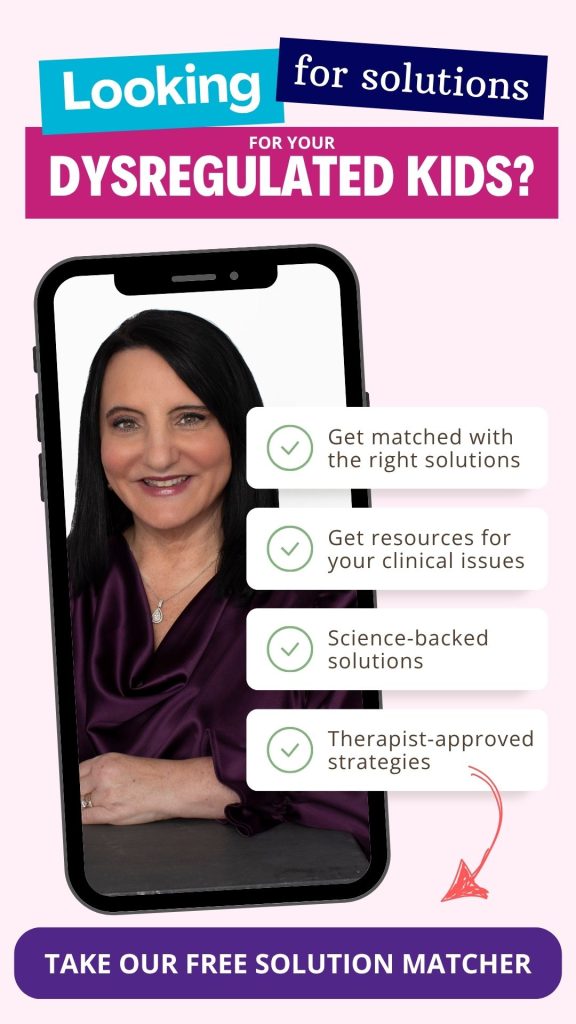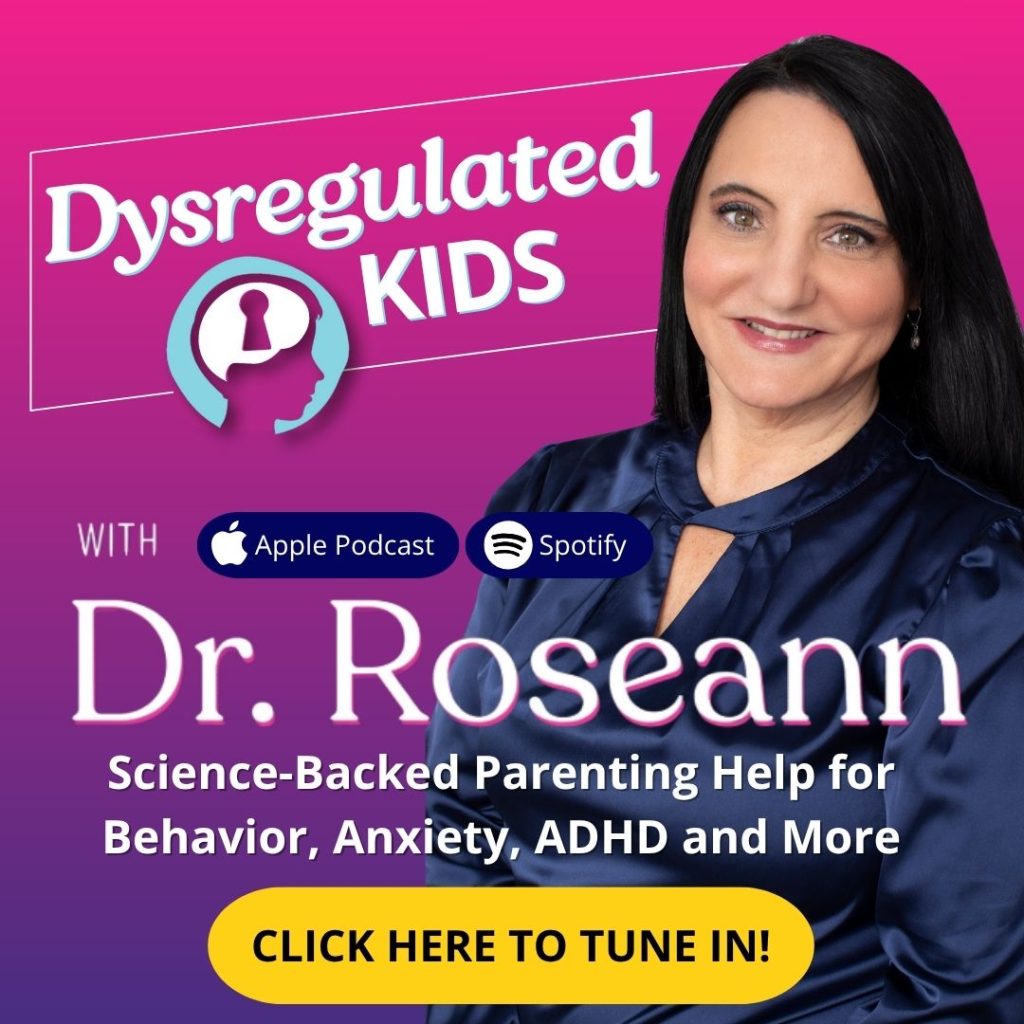Estimated reading time: 7 minutes
When your 7-year-old survives on chicken nuggets and crackers and refuses to eat anything else, it’s natural to feel like you’re failing—but the psychology of picky eaters shows this behavior is rooted in brain science, not bad parenting.
A study from the Avon Longitudinal Study of Parents and Children (ALSPAC) found that about 16% of children ages 3–5 showed picky eating, and many remained selective from ages 4 to 9. Understanding this helps shift your approach from frustration to compassion while building nutrition strategies that work for your child.
This guide will help you decode food behaviors, apply brain-based nutrition solutions, and create calmer mealtimes that support both your child’s development and your family’s wellbeing. You’ll also see why traditional approaches often backfire—and what science says really helps.
What’s the Psychology Behind Your Child’s Food Choices?
The psychology of picky eaters runs much deeper than simple preference—it’s a complex interplay of sensory processing, temperament, and neurological development.
When your child refuses new foods, their brain is actually protecting them from perceived threats.
Research reveals that at 12 months of age, children who were more exuberant about new toys were more enthusiastic about new foods as well.
Babies who react strongly to new toys often approach new foods with the same caution. That means picky eating usually isn’t about being stubborn—it’s about how your child’s brain handles new experiences. Understanding this helps us respond with patience instead of frustration.

Key Psychological Factors in Selective Eating:
- Food neophobia: It’s normal for kids to get cautious with diet between ages 2–6—it’s actually a survival instinct wired into their brains.
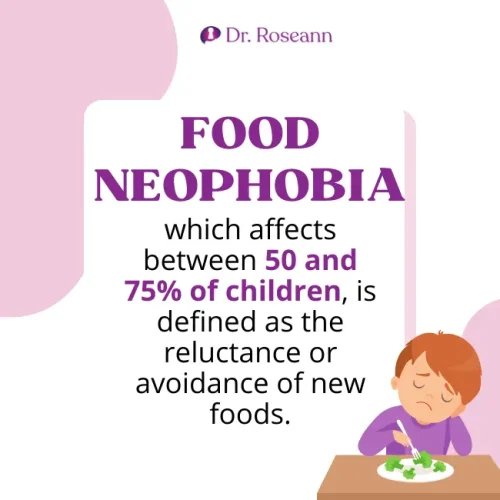
- Sensory hypersensitivity: Some kids experience tastes, smells, or textures much more intensely, which makes broccoli feel like an “assault” instead of just a vegetable.
- Control and autonomy: Saying “no” to food can be your child’s way of saying, “I need some control here,” especially when so much of their day feels dictated by adults.
- Anxiety and stress: A bad experience (like choking or gagging) can turn into an “avoid at all costs” pattern, even if the food itself isn’t the problem.
Consider Katie, a 5-year-old who only eats beige foods. Her mother felt embarrassed at family gatherings until she learned that Katie’s brain was genuinely experiencing new foods as threatening. Understanding this shifted their approach from forcing to supporting, leading to gradual expansion of Emma’s accepted foods over six months.
It’s not bad parenting—it’s neurobiology in action.

When Does Picky Eating Become an Eating Disorder?
While most selective eating in children is developmentally normal, certain red flags indicate when professional intervention becomes necessary.
“We typically start seeing kids who struggle with picky eating when they are 7 or 8 years old,” says Jerry Bubrick, PhD, a clinical psychologist, noting this is when parents realize normal picky eating has evolved into something more serious.
The transition from typical picky eating to Avoidant/Restrictive Food Intake Disorder (ARFID) involves significant impairment in functioning, not just preference.
When food restrictions begin affecting growth, social situations, or family dynamics severely, it’s time to seek support.
Warning Signs That Require Professional Evaluation:
| Warning Sign | Why It Matters |
|---|---|
| Significant weight loss or failure to gain weight appropriately | May signal growth or health concerns requiring immediate attention. |
| Elimination of entire food groups | Increases risk of nutritional deficiencies and limited diet variety. |
| Extreme emotional reactions to food exposure or mealtime | Suggests deeper anxiety, sensory, or regulation issues beyond typical picky eating. |
| Social isolation due to food restrictions | When eating challenges affect friendships, school, or family activities. |
| Physical symptoms like gagging, vomiting, or panic responses | Indicates the nervous system is in distress, not just being “choosy.” |
| Nutritional deficiencies confirmed through medical testing | Confirms the body isn’t getting what it needs to function and develop properly. |
Take Ben, for example. At first, his parents thought his extreme food pickiness was ‘just a phase.’ But when he started losing weight and even skipped birthday parties because of food anxiety, they realized this wasn’t simply picky eating—it was impacting his health and happiness.
With proper intervention, Ben learned coping strategies and gradually expanded his diet while maintaining his emotional wellbeing.
The key distinction is functional impairment—when food behaviors significantly interfere with your child’s growth, development, or quality of life.
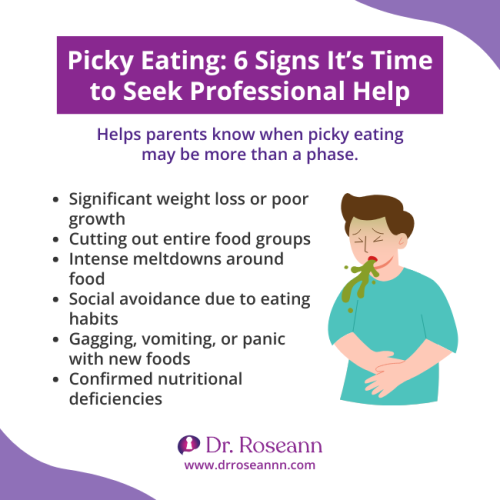
Brain Science Spotlight
Research from University College London (UCL) shows that picky eating isn’t just a “phase”—it has strong genetic roots. Twin studies found that genetics explain about 60% of food fussiness at 16 months, and that influence grows to around 74% by early adolescence.
Brain studies also show why some kids struggle so much. Adolescents who are fussy eaters have less brain activity in taste and sensory regions when they see or try fruits and veggies compared to high-calorie foods. Simply put—their brains don’t light up the same way.
That’s why telling your child to “just eat it” usually backfires. When the amygdala—the brain’s fear center—reacts to new textures or smells, it triggers real distress. This isn’t stubbornness; it’s how their brain is wired.
What this means for your family: Slow, gentle exposure works better than pressure. Over time, positive experiences help the brain build new pathways, and that’s when change starts to happen.

How Can Families Create Successful Nutrition Plans for Picky Eaters?
Creating nutrition plans for picky eaters means shifting from a “balanced meal” to a “balanced week” approach. Instead of stressing over every bite, build on your child’s safe foods and pair them for better nutrition—like waffles with blueberries for a more balanced option.
The BUILD Method for Nutrition Planning:
- Base meals around accepted foods
- Understand nutritional gaps through observation
- Introduce new foods gradually alongside safe options
- Link similar textures and flavors to expand variety
- Document progress to stay motivated
Natasha’s 4-year-old would only eats pasta, bananas, and milk. Instead of forcing vegetables, Natasha started by offering banana slices with pasta (accepted), then transitioning to yellow bell pepper strips (similar color and mild sweetness), eventually expanding to other yellow foods. Within three months, her son was eating squash, corn, and even some orange foods.
The secret is incremental progression, not dramatic overhauls. Your child’s nervous system needs time to adapt to new sensory experiences.
What Are the Best Family Meal Strategies for Picky Eating?
Effective family meal strategies for picky eaters focus on creating positive associations with food and mealtimes rather than forcing consumption. Establish mealtime routines. Try to eat your dinner around the same time every night; keep distractions like phones and TV out of mealtime; talk about pleasant topics so kids associate positive feelings with mealtime.
The “Division of Responsibility” approach works exceptionally well for selective eaters: parents decide what, when, and where food is served, while children decide whether and how much to eat from what’s offered.
Evidence-Based Mealtime Strategies:
- Serve family style with all foods in serving dishes
- Include one “safe food” at every meal
- Model adventurous eating without commenting on your child’s choices
- Keep mealtimes pleasant and conversation-focused
- Avoid bribes, rewards, or negotiations around food
Dr. Roseann’s Therapist Tip
In my 30+ years of practice, I’ve seen the biggest progress when families stop treating meals as battles and start celebrating small wins. Touching a new food or putting it on the plate is neurological progress.
Try this today: Serve a tiny portion of a new food alongside safe foods with no pressure—just let your child see you enjoy it.
Why it works: Gentle, repeated exposure helps the nervous system adapt while keeping kids safe and in control.
Remember: Behavior is communication. Your child isn’t defiant—they just need more time and support. It’s gonna be OK.
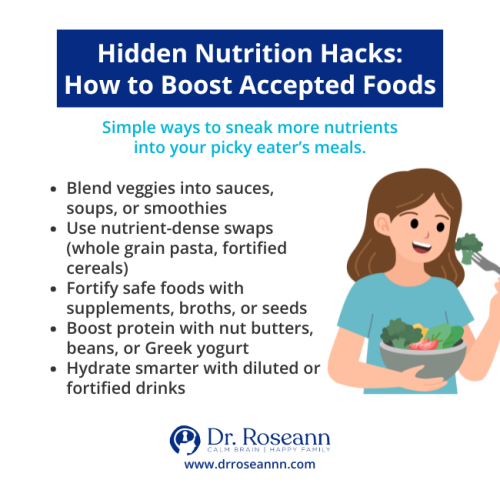
How Can You Reduce Mealtime Battles While Improving Nutrition?
Reducing mealtime stress means letting go of control and focusing on a calm, structured environment. When pressure is removed and parents model healthy eating, kids feel safe—and that safety often sparks the curiosity needed to try new foods.
The PEACE Method for Stress-Free Meals:
- Present food without expectation
- Eat together as a family when possible
- Avoid commenting on your child’s eating
- Create pleasant mealtime conversations
- End meals calmly regardless of consumption
Trust the process: When you stop fighting, your child can start exploring. It takes time, but the results are lasting and built on genuine acceptance rather than compliance.
Supporting Your Picky Eater’s Journey Forward
Understanding the psychology of picky eaters turns mealtimes from battles into chances for connection. It’s not about forcing vegetables—it’s about calming your child’s nervous system, meeting nutrition needs, and fostering a healthy relationship with food. Every child’s journey is different, and patience, consistency, and compassion make all the difference.
With evidence-based strategies and the right support, most kids gradually expand their food acceptance. You’re not alone—thousands of families navigate this successfully.
FAQs
Is picky eating linked to autism or ADHD?
Yes, children with autism or ADHD are more likely to experience sensory-based picky eating.
Can picky eating affect my child’s health long-term?
If the diet is very limited, it can lead to nutritional deficiencies, but most mild cases do not cause harm.
Should I force my child to try new foods?
No. Forcing often backfires and increases anxiety. Gentle exposure works better.
What’s the difference between picky eating and ARFID?
ARFID goes beyond picky eating—it causes severe distress and nutritional risk and often requires professional treatment.
Citations:
Taylor, C. M., Northstone, K., Wernimont, S. M., Emmett, P. M., & ALSPAC Study Team. (2016). Picky eating in preschool children: Associations with dietary fibre intakes and stool hardness. Appetite, 100, 263–271. https://doi.org/10.1016/j.appet.2016.02.024
Dovey, T. M., Staples, P. A., Gibson, E. L., & Halford, J. C. G. (2008). Food neophobia and ‘picky/fussy’ eating in children: A review. Appetite, 50(2–3), 181–193. https://doi.org/10.1016/j.appet.2007.09.009
Smith, A. D., Herle, M., Fildes, A., Cooke, L., Steinsbekk, S., Llewellyn, C. H., & Jaddoe, V. W. V. (2017). Genetic and environmental influences on food fussiness and food neophobia in children: A twin study. Nutrients, 9(6), 563. https://doi.org/10.3390/nu9060563
Always remember… “Calm Brain, Happy Family™”
Disclaimer: This article is not intended to give health advice and it is recommended to consult with a physician before beginning any new wellness regime. *The effectiveness of diagnosis and treatment vary by patient and condition. Dr. Roseann Capanna-Hodge, LLC does not guarantee certain results.
Are you looking for SOLUTIONS for your struggling child or teen?
Dr. Roseann and her team are all about science-backed solutions, so you are in the right place!

©Roseann Capanna-Hodge


